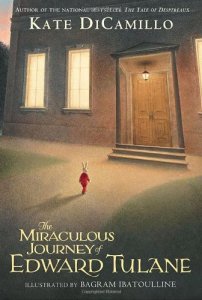Today was Kate DiCamillo day and am I ever glad I started with The Magician’s Elephant. Although that tale was about something dark–depression and loss of hope–The Miraculous Journey of Edward Tulane is darker and the hope is much more subtle. I cannot wait to hear what my seven-year-old thinks of both.
Edward Tulane is a three-foot tall china rabbit with real rabbit fur ears and an extensive wardrobe of silk clothes and a gold pocket watch. He belongs to young Abilene, who adores him and talks to him, dresses him, and protects him until the day aboard a ship when young boys get him and he ends up at the bottom of the ocean. Edward had previously spent his days thinking how fine he was and now he spent his days thinking how badly treated he was. When a storm tosses him up he goes to live with a kindly older couple, who talk to him and dress him, but cannot protect him from their adult daughter, who sends him to the trash. From there he lives with a hobo and his dog, is a scarecrow, lives with a dying young girl and her brother, and then spends years on a doll-maker’s shelf until he is once again chosen to by a young girl.
Through these cycles, Edward gets a heart–first in sorrow as he realizes what he has lost, then love. Love brings him sorrow again and again as he is separated from the people he loves, often without the chance to say goodbye. He grows a heart and wishes he did not have one.
Edward has a promise of a happy ending, but it’s abrupt and the happiness is outweighed, by and large, by the sadness in this tale. One of the images of Edward is of him as a scarecrow and I stared at it trying to decide if he was supposed to look as if he were being crucified. In a later chapter he is broken and has a death experience–the light, seeing the people he loved and lost, moving towards heaven–until he is pulled back. He is saved.
DiCamillo adds a coda to this novel that recaps, in minimalist fashion, the entire tale, and tells us that Edward did love again–but this is not in the body of the tale. In music a coda is a passage that brings a piece to an end. Here it is in a smaller font and titled “Coda.” It looks like publisher’s material. Why this choice to tell that Edward had a happy ending? Once again, this choice helps the darkness outweigh the light in this tale.
She precedes the tale with this quote from Stanley Kunitz: “The heart breaks and breaks and lives by breaking. It is necessary to go through dark and deeper dark and not to turn.”
I hope DiCamillo has gone through her dark and deeper dark and has returned to a world with more light, like that of Despereaux.
Finished 3/3/15
